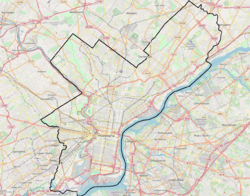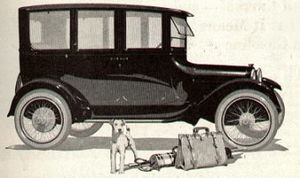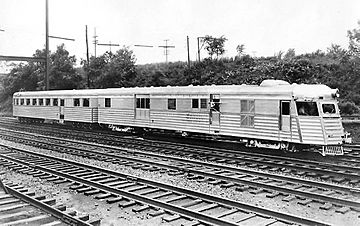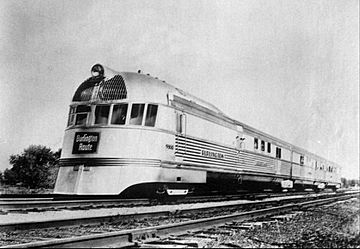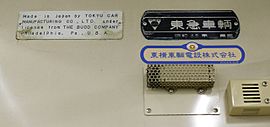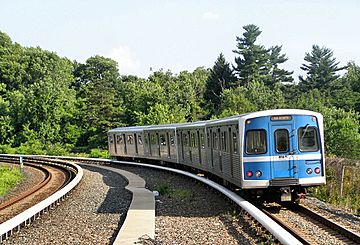Budd Company facts for kids
| Private | |
| Industry | Rail transport |
| Founded | 1912 in Philadelphia, Pennsylvania, United States |
| Defunct | 1987 |
| Headquarters |
United States
|
|
Area served
|
Worldwide |
|
Edward G. Budd Manufacturing Company
|
|
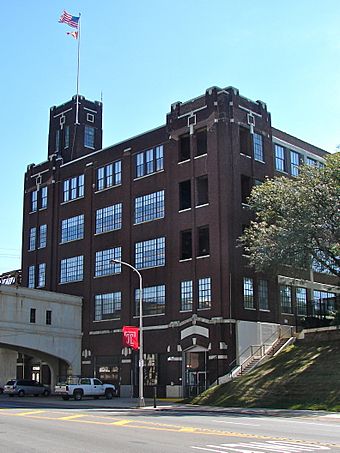
The Budd manufacturing facility in Philadelphia
|
|
| Location | 2450 W. Hunting Park Ave., Philadelphia, Pennsylvania, United States |
|---|---|
| Area | 70 acres (28 ha) |
| Built | 1917 |
| Architect | Giffels & Vallet, Inc.; Albert Kahn & Associates |
| Architectural style | 20th Century Industrial |
| NRHP reference No. | 07001328 |
| Added to NRHP | December 27, 2007 |
The Budd Company was a famous American company from the 20th century. It was known for making metal parts for cars and building cool stainless steel trains. They also made parts for airplanes and even space vehicles!
The company started in 1912 in Philadelphia, Pennsylvania. It was founded by Edward G. Budd. He became famous for inventing the first all-steel car bodies in 1913. His company also created a special way to join stainless steel, called "shotweld," in the 1930s. This method helped keep the steel from rusting.
Later, the Budd Company became part of a bigger company called Budd Thyssen in 1978. Then, in 1999, it became part of ThyssenKrupp Budd. The parts of the company that made car bodies were sold in 2006. Today, the Budd Company doesn't make things anymore. It mainly exists to help its retired employees.
Contents
Cool Car Innovations
Edward G. Budd was a pioneer in making cars. He developed the very first car bodies made entirely of steel. This was a big deal because it made cars stronger and safer.
His first major supporters were the Dodge brothers. Starting in 1913, they bought 70,000 all-steel car bodies from Budd in 1916. Soon after, Dodge also started using all-steel sedan bodies from Budd.
The Budd Company also worked with companies in other countries. From 1926 to 1936, they helped start and owned part of The Pressed Steel Company in England. This company built car bodies for Morris Motors and others. Budd also worked with Ambi-Budd in Germany, which supplied parts to famous car brands like Adler and BMW.
During World War II, Budd made the first "safety" two-piece truck wheel. This wheel was used a lot by the US military. They also built truck cargo bodies for the military.
Budd helped develop the first mass-produced "unibody" car in North America, the Nash 600. A unibody car means the body and frame are built as one piece, making the car lighter and stronger.
In the 1980s, Budd's Plastics Division created a special reinforced plastic material. This material could be stamped into car body panels just like metal. The Pontiac Fiero car used some of these plastic parts, like its side panels and roof.
Amazing Trains
From the 1930s until 1987, the Budd Company was a top maker of stainless steel streamlined passenger trains. These trains were known for their sleek look and durability.
Early Passenger Trains
Budd built the famous Pioneer Zephyr for the Chicago, Burlington and Quincy Railroad in 1934. This was one of the first complete streamlined trains. The General Pershing Zephyr in 1938 was the first to use disc brakes on passenger cars. Budd made thousands of lightweight stainless steel passenger cars for new trains across the US.
In 1949, Budd built ten special stainless steel R11 subway cars for New York City. These were meant for a new subway line.
In the late 1940s, a railroad in Chicago wanted to carry more people on its commuter trains without adding more cars. Budd came up with a clever idea: "Gallery" cars. These cars were taller than normal, with two levels of seating. The upper level had an open center so the conductor could easily collect tickets from everyone.
These Gallery cars were delivered in 1950 and 1951. They were the first commuter cars to have air conditioning. This made rides much more comfortable for passengers.
The Atchison, Topeka and Santa Fe Railway also asked Budd to improve their trains. In 1954, Budd delivered two special two-level cars called Hi-Level prototypes. These cars had seating on both levels and stairs to connect to other cars. They were very popular with passengers.
Because of their success, Santa Fe ordered many more Hi-Level cars from Budd. These included coaches, dining cars, and lounge cars. Some even had partially glassed-in roofs, like the "Big Dome" lounge cars. These trains were used on famous routes like the El Capitan between Chicago and Los Angeles.
Later Passenger Trains

Budd continued to build Gallery cars for Chicago commuter lines in the 1960s and 1970s. Many of these cars are still used today! The Santa Fe Hi-Level cars inspired the modern Amtrak Superliner trains, which are used on many routes today.
Budd trains built for Canada's Canadian Pacific Railway in 1955 are still running today with Via Rail Canada. Also, Budd cars from 1951 are still used in Argentina for a weekly service from Buenos Aires to Mar del Plata.
Budd's special designs were also used in other countries like Brazil, France, and Japan. For example, the Tokyu Car Corporation in Japan made stainless steel commuter cars using Budd's methods.
Rail Diesel Cars (RDCs)
In 1949, Budd introduced the Rail Diesel Car (RDC). This was a self-propelled stainless steel train that was like a "train in one car." It was perfect for railway lines that didn't have many passengers.
More than 300 RDCs were built. Some are still used today in places like Canada, the United States, and Australia.
Electric Trains (EMUs)

In the late 1950s, Budd built a prototype electric train called the Pioneer III. Later, six of these were bought by the Pennsylvania Railroad and became known as Silverliner I cars. They were used for commuter service in Philadelphia.
Budd also built the original Metroliner cars for high-speed service on the Northeast Corridor. These trains were very fast, tested up to 160 mph (260 km/h).
Subway Cars
In 1960, Budd made the first stainless steel subway cars for Philadelphia's Market-Frankford Line. There were 270 of these M-3 cars. Some people called them "Almond Joys" because of the shape of their roof vents.
These cars were replaced in the late 1990s. Some were moved to another line, the Norristown High Speed Line.
Cool Transportation Inventions
Aviation
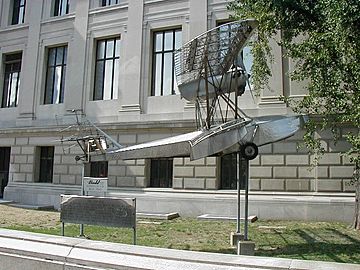
In 1930, Budd started working in the aviation industry. They made airplane wheels and stainless steel wing parts. They even built a four-seat airplane called the Budd BB-1 Pioneer. This was the first airplane ever built with a stainless steel structure!
Only one BB-1 Pioneer was built. It flew for about 1,000 hours, traveling around the United States and Europe. In 1934, this plane was put on display outside the Franklin Institute in Philadelphia.
During World War II, Budd designed and built the RB-1 Conestoga transport airplane for the United States Navy. This plane also used a lot of stainless steel instead of aluminum.
Automobiles
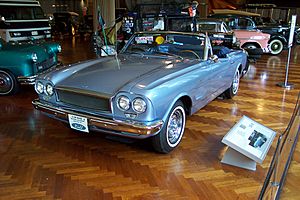
In 1962, Budd created a special concept car called the XR-400 for the American Motors Corporation (AMC). It was a sporty car, but it never went into production.
Before that, in 1961, Budd tried to sell a similar idea to Ford. They combined parts of a 1957 Ford Thunderbird and a 1961 Ford Falcon to make a cool convertible. But Ford decided to develop its own car, which became the famous Mustang.
In 1965, Budd also designed and made a front disc brake system for some Chrysler and Dodge cars from 1966 to 1968.
Budd's Divisions
By the end of the 1950s, Budd had different parts of its company that focused on various things:
- Budd Lewyt Electronics, Inc. made special computer systems and communication equipment.
- Tatnall Measuring Systems Division created tools for testing materials and measuring strain.
- Continental-Diamond Fibre Corporation made special heat-resistant materials and plastics.
- Defense Division worked on advanced aerospace and atomic structures for defense.
- Nuclear Systems Division made equipment for checking materials using radiation.
- Electronic Controls Section made controls for welding machines used in the aircraft industry.
Last Years of Train Production
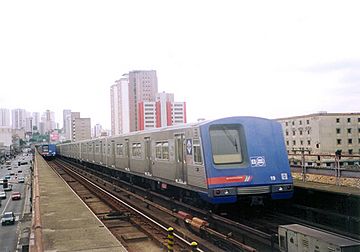
Budd built subway cars for Chicago, New York City, and the PATCO Speedline. They also made commuter trains for the Long Island Rail Road and Metro-North Railroad. The subway cars for the Baltimore Metro and Miami Metrorail were also built by Budd.
Amtrak's Amfleet I and Amfleet II cars were built by Budd in the 1970s and 1980s. Budd also made a modern diesel passenger car called the Budd SPV-2000. However, this car had many problems and was retired early.
In 1978, Budd started to focus more on the car industry. It was bought by Thyssen AG. On April 3, 1987, Budd stopped making trains at its factory in Philadelphia. They sold their train designs to another company, Bombardier Transportation.
Modern Role in Car Industry
When Thyssen merged with Krupp in 1999, Budd Thyssen became ThyssenKrupp Budd Co. in North America. In 2006, ThyssenKrupp sold most of Budd's operations. The parts that made car bodies were sold to Martinrea International. The plastics and aluminum parts were sold to other companies. Budd's last remaining operation was sold in 2012.
Preserving Budd's Legacy
Many Budd trains are still around today! They are kept by museums or private owners. People love them because they were built so well and looked so elegant.
Pennsylvania
The Railroad Museum of Pennsylvania in Strasburg has several Budd cars. These include a 1937 observation car from the "Crusader" train and a 1968 Metroliner car.
The Bellefonte Historical Railroad Society has two Budd Rail Diesel Cars (RDCs).
New York
The New York Transit Museum has a 1949 R11 and a 1964 R32 subway car pair from Budd.
Indiana
The Indiana Transportation Museum has fourteen Budd coaches that were built for the Atchison, Topeka, and Santa Fe railroad. Eight of them are restored and used for special train rides.
Illinois
The Illinois Railway Museum has the Nebraska Zephyr train and some CTA 2200 series subway cars. The Museum of Science and Industry in Chicago has the famous Pioneer Zephyr train.
California
The Western Pacific Railroad Museum in Portola, California, has several Budd cars. These include parts of the California Zephyr train, like the dome lounge car Silver Hostel.
Missouri
The St. Louis Museum of Transportation owns the Zephyr diner car Silver Spoon. It also has the Budd-designed locomotive Silver Charger.
Massachusetts
Bedford Depot has a restored Rail Diesel Car (#6211).
Portugal
The National Railroad Museum in Entroncamento, Portugal, has a pair of Budd cars built in 1940.
Argentina
Several Budd coaches and dining cars are still running in Argentina. They are used for a luxury service between Buenos Aires and Mar del Plata during the summer.
Wind Power Contribution
In 1939, the Budd company also helped design and make the stainless steel skin for the blades of the Smith–Putnam wind turbine. For forty years, this was the largest wind turbine in the world!
Budd's Factories
Budd had many factories, especially in the Philadelphia area. One car parts factory on Hunting Park Avenue closed in 2002. In 1972, the company moved its main office from Philadelphia to Troy, Michigan. In 2002, Budd had 39 factories and about 12,000 employees in North America.
Images for kids
See also
 In Spanish: Budd Company para niños
In Spanish: Budd Company para niños


